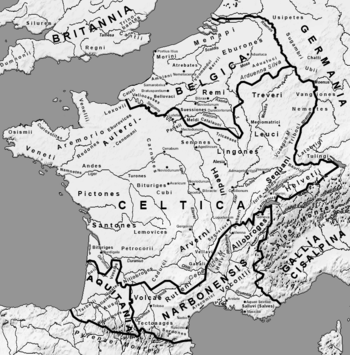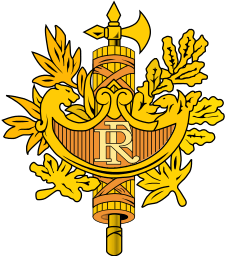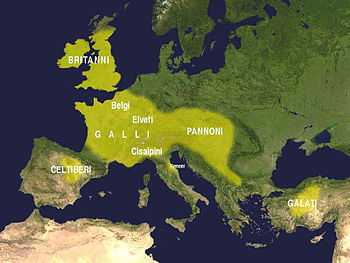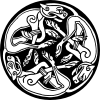Gaul

Part of a series on the |
||||||||||||||||||||||||||||||
|---|---|---|---|---|---|---|---|---|---|---|---|---|---|---|---|---|---|---|---|---|---|---|---|---|---|---|---|---|---|---|
| History of France | ||||||||||||||||||||||||||||||
.svg.png)   | ||||||||||||||||||||||||||||||
|
||||||||||||||||||||||||||||||
|
||||||||||||||||||||||||||||||
|
||||||||||||||||||||||||||||||
|
||||||||||||||||||||||||||||||
|
||||||||||||||||||||||||||||||
|
||||||||||||||||||||||||||||||
| France portal | ||||||||||||||||||||||||||||||
Gaul (Latin: Gallia) was a region of Western Europe during the Iron Age that was inhabited by Celtic tribes, encompassing present day France, Luxembourg, Belgium, most of Switzerland, parts of Northern Italy, as well as the parts of the Netherlands and Germany on the west bank of the Rhine. It covered an area of 190,800 mi² or 494,169 km².[1] According to the testimony of Julius Caesar, Gaul was divided into three parts: Gallia Celtica, Belgica and Aquitania. Archaeologically, the Gauls were bearers of the La Tène culture, which extended across all of Gaul, as well as east to Rhaetia, Noricum, Pannonia and southwestern Germania during the 5th to 1st centuries BC. During the 2nd and 1st centuries BC, Gaul fell under Roman rule: Gallia Cisalpina was conquered in 203 BC and Gallia Narbonensis in 123 BC. Gaul was invaded by the Cimbri and the Teutons after 120 BC, who were in turn defeated by the Romans by 103 BC. Julius Caesar finally subdued the remaining parts of Gaul in his campaigns of 58 to 51 BC.
Roman control of Gaul lasted for five centuries, until the last Roman rump state, the Domain of Soissons, fell to the Franks in AD 486. While the Celtic Gauls had lost their original identities and language during Late Antiquity, becoming amalgamated into a Gallo-Roman culture, Gallia remained the conventional name of the territory throughout the Early Middle Ages, until it acquired a new identity as the Capetian Kingdom of France in the high medieval period. Gallia remains a name of France in modern Latin (besides the alternatives Francia and Francogallia).
Name
The Greek and Latin names Galatia (first attested by Timaeus of Tauromenion in the 4th century BC), and Gallia are ultimately derived from a Celtic ethnic term or clan Gal(a)-to-.[2] The Galli of Gallia Celtica were reported to refer to themselves as Celtae by Caesar. This name, from a stem *kel-to has been suggested as ultimately derived from a common origin with the names in Gal- by certain linguists. Hellenistic folk etymology connected the name of the Galatians (Γαλάται, Galátai) to the supposedly "milk-white" skin (γάλα, gála "milk") of the Gauls.[3]
The English Gaul is from French Gaule and is unrelated to Latin Gallia, despite superficial similarity (Latin Gallia would have regularly been turned to *Jaille in French). As adjectives, English has the two variants Gaulish and Gallic. The two adjectives are used synonymously, as "pertaining to Gaul or the Gauls", although the Celtic language or languages spoken in Gaul is predominantly known as Gaulish.
The name Gaul is derived from the Germanic term walha, "foreigner, Romanized person", an exonym applied by Germanic speakers to Celts and Latin-speaking people indiscriminately, making it partially cognate with the names Wales and Wallachia.[4] The Germanic w- is regularly rendered as gu- / g- in French (cf. guerre = war, garder = ward), and the diphthong au is the regular outcome of al before a following consonant (cf. cheval ~ chevaux). Gaule or Gaulle can hardly be derived from Latin Gallia, since g would become j before a (cf. gamba > jambe), and the diphthong au would be unexplained; the regular outcome of Latin Gallia is Jaille in French which is found in several western placenames.[5][6]
Also unrelated in spite of superficial similarity, are the nams Galli and Gael.[7] The Irish word gall did originally mean "a Gaul", i.e. an inhabitant of Gaul, but its meaning was later widened to "foreigner", to describe the Vikings, and later still the Normans.[8] The dichotomic words gael and gall are sometimes used together for contrast, for instance in the 12th-century book Cogad Gáedel re Gallaib.
History
Pre-Roman Gaul

The early history of the Gauls is predominantly a work in archaeology—there being little written information (save perhaps what can be gleaned from coins) concerning the peoples that inhabited these regions—and the relationships between their material culture, genetic relationships (the study of which has been aided, in recent years, through the field of archaeogenetics), and linguistic divisions rarely coincide.
Before the rapid spread of the La Tène culture in the 5th to 4th centuries BC, the territory of eastern and southern France already participated in the Late Bronze Age Urnfield culture (c. 12th to 8th centuries BC.) out of which the early iron-working Hallstatt culture (7th to 6th centuries BC) would develop. By 500 BC, there is strong Hallstatt influence throughout most of France (except for the Alps and the extreme north-west).
Out of this Hallstatt background, during the 7th and 6th century presumably representing an early form of Continental Celtic culture, the La Tène culture arises, presumably under Mediterranean influence from the Greek, Phoenician, and Etruscan civilizations, spread out in a number of early centers along the Seine, the Middle Rhine and the upper Elbe. By the late 5th century BC, La Tène influence spreads rapidly across the entire territory of Gaul. The La Tène culture developed and flourished during the late Iron Age (from 450 BC to the Roman conquest in the 1st century BC) in France, Switzerland, Italy, Austria, southwest Germany, Bohemia, Moravia, Slovakia and Hungary. Farther north extended the contemporary pre-Roman Iron Age culture of northern Germany and Scandinavia.
The major source of materials on the Celts of Gaul was Poseidonios of Apamea, whose writings were quoted by Timagenes, Julius Caesar, the Sicilian Greek Diodorus Siculus, and the Greek geographer Strabo.[9]
In the 4th and early 3rd century BC, Gallic clan confederations expanded far beyond the territory of what would become Roman Gaul (which defines usage of the term "Gaul" today), into Pannonia, Illyria, northern Italy, Transylvania and even Asia Minor. By the 2nd century BC, the Romans described Gallia Transalpina as distinct from Gallia Cisalpina. In his Gallic Wars, Julius Caesar distinguishes among three ethnic groups in Gaul: the Belgae in the north (roughly between Rhine and Seine), the Celtae in the center and in Armorica, and the Aquitani in the southwest, the southeast being already colonized by the Romans. While some scholars believe the Belgae south of the Somme were a mixture of Celtic and Germanic elements, their ethnic affiliations have not been definitively resolved. One of the reasons is political interference upon the French historical interpretation during the 19th century.
In addition to the Gauls, there were other peoples living in Gaul, such as the Greeks and Phoenicians who had established outposts such as Massilia (present-day Marseille) along the Mediterranean coast.[10] Also, along the southeastern Mediterranean coast, the Ligures had merged with the Celts to form a Celto-Ligurian culture.
In the 2nd century BC, Mediterranean Gaul had an extensive urban fabric and was prosperous, while the best known cities in northern Gaul include the Biturigian capital of Avaricum (Bourges), Cenabum (Orléans), Autricum (Chartres) and the excavated site of Bibracte near Autun in Saône-et-Loire, along with a number of hillforts (or oppida) used in times of war. The prosperity of Mediterranean Gaul encouraged Rome to respond to pleas for assistance from the inhabitants of Massilia, who were under attack by a coalition of Ligures and Gauls. The Romans intervened in Gaul in 125 BC, and by 121 BC they had conquered the Mediterranean region called Provincia (later named Gallia Narbonensis). This conquest upset the ascendancy of the Gaulish Arverni peoples.
Conquest by Rome

The Roman proconsul and general Julius Caesar pushed his army into Gaul in 58 BCE, on the pretext of assisting Rome's Gaullish allies against the migrating Helvetii. With the help of various Gallic clans (e.g. the Aedui) he managed to conquer nearly all of Gaul. While militarily just as strong as the Romans, the internal division between the Gallic tribes guaranteed an easy victory for Caesar, and Vercingetorix's attempt to united the Gauls against Roman invasion came too late.[11][12] Julius Caesar was checked by Vercingetorix at a siege of Gergorvia, a fortified town in the center of Gaul. Caesar's alliances with many Gallic clans broke. Even the Aedui, their most faithful supporters, threw in their lot with the Arverni, but the ever loyal Remi (best known for its cavalry) and Lingones sent troops to support Caesar. The Germani of the Ubii also sent cavalry, which Caesar equipped with Remi horses. Caesar captured Vercingetorix in the Battle of Alesia, which ended the majority of Gallic resistance to Rome.
As many as a million people (probably 1 in 5 of the Gauls) died, another million were enslaved, 300 clans were subjugated and 800 cities were destroyed during the Gallic Wars. The entire population of the city of Avaricum (Bourges) (40,000 in all) were slaughtered.[13] During Julius Caesar's campaign against the Helvetii (present-day Switzerland) approximately 60% of that nation was destroyed, and another 20% was taken into slavery.
Roman Gallia
The Gaulish culture then was massively submerged by Roman culture, Latin was adopted by the Gauls; Gaul, or Gallia, was absorbed into the Roman Empire, all the administration changed, and Gauls eventually became Roman citizens.[14] From the third to 5th centuries, Gaul was exposed to raids by the Franks. The Gallic Empire, consisting of the provinces of Gaul, Britannia, and Hispania, including the peaceful Baetica in the south, broke away from Rome from 260 to 273.
Following the Frankish victory at the Battle of Soissons in 486 AD, Gaul (except for Septimania) came under the rule of the Merovingians, the first kings of France. Gallo-Roman culture, the Romanized culture of Gaul under the rule of the Roman Empire, persisted particularly in the areas of Gallia Narbonensis that developed into Occitania, Gallia Cisalpina and to a lesser degree, Aquitania. The formerly Romanized north of Gaul, once it had been occupied by the Franks, would develop into Merovingian culture instead. Roman life, centered on the public events and cultural responsibilities of urban life in the res publica and the sometimes luxurious life of the self-sufficient rural villa system, took longer to collapse in the Gallo-Roman regions, where the Visigoths largely inherited the status quo in the early 5th century. Gallo-Roman language persisted in the northeast into the Silva Carbonaria that formed an effective cultural barrier, with the Franks to the north and east, and in the northwest to the lower valley of the Loire, where Gallo-Roman culture interfaced with Frankish culture in a city like Tours and in the person of that Gallo-Roman bishop confronted with Merovingian royals, Gregory of Tours.
-

Massalia (modern Marseille) silver coin with Greek legend, 5th–1st century BC.
-

Gold coins of the Gaul Parisii, 1st century BC, (Cabinet des Médailles, Paris).
-
Roman silver Denarius with the head of captive Gaul 48 BC, following the campaigns of Julius Caesar.
The Gauls


Social structure, indigenous nation and clans
The Druids were not the only political force in Gaul, however, and the early political system was complex, if ultimately fatal to the society as a whole. The fundamental unit of Gallic politics was the clan, which itself consisted of one or more of what Caesar called pagi. Each clan had a council of elders, and initially a king. Later, the executive was an annually-elected magistrate. Among the Aedui, a clan of Gaul, the executive held the title of Vergobret, a position much like a king, but his powers were held in check by rules laid down by the council.
The regional ethnic groups, or pagi as the Romans called them (singular: pagus; the French word pays, "region", comes from this term), were organized into larger multi-clan groups the Romans called civitates. These administrative groupings would be taken over by the Romans in their system of local control, and these civitates would also be the basis of France's eventual division into ecclesiastical bishoprics and dioceses, which would remain in place—with slight changes—until the French Revolution.
Although the individual clans were moderately stable political entities, Gaul as a whole tended to be politically divided, there being virtually no unity among the various clans. Only during particularly trying times, such as the invasion of Caesar, could the Gauls unite under a single leader like Vercingetorix. Even then, however, the faction lines were clear.
The Romans divided Gaul broadly into Provincia (the conquered area around the Mediterranean), and the northern Gallia Comata ("free Gaul" or "long haired Gaul"). Caesar divided the people of Gallia Comata into three broad groups: the Aquitani; Galli (who in their own language were called Celtae); and Belgae. In the modern sense, Gaulish peoples are defined linguistically, as speakers of dialects of the Gaulish language. While the Aquitani were probably Vascons, the Belgae would thus probably be a mixture of Celtic and Germanic elements.
Julius Caesar, in his book, Commentarii de Bello Gallico, comments:
| “ |
All Gaul is divided into three parts, one of which the Belgae inhabit, the Aquitani another, and those who in their own language are called Celts, in ours Gauls, the third. All these differ from each other in language, customs and laws. The River Garonne separates the Gauls from the Aquitani; the rivers Marne and the Seine separate them from the Belgae. Of all these, the Belgae are the bravest, because they are furthest from the civilisation and refinement of (our) Province, and merchants least frequently resort to them, and import those things which tend to effeminate the mind; and they are the nearest to the Germani, who dwell beyond the Rhine, with whom they are continually waging war; for which reason the Helvetii also surpass the rest of the Gauls in valour, as they contend with the Germani in almost daily battles, when they either repel them from their own territories, or themselves wage war on their frontiers. One part of these, which it has been said that the Gauls occupy, takes its beginning at the River Rhône; it is bounded by the Garonne, the Atlantic Ocean, and the territories of the Belgae; it borders, too, on the side of the Sequani and the Helvetii, upon the Rhine, and stretches toward the north. The Belgae rises from the extreme frontier of Gaul, extend to the lower part of the River Rhine; and look toward the north and the rising sun. Aquitania extends from the Garonne to the Pyrenees and to that part of the Atlantic (Bay of Biscay) which is near Spain: it looks between the setting of the sun, and the north star. |
” |
Religion
The Gauls practiced a form of animism, ascribing human characteristics to lakes, streams, mountains, and other natural features and granting them a quasi-divine status. Also, worship of animals was not uncommon; the animal most sacred to the Gauls was the boar, which can be found on many Gallic military standards, much like the Roman eagle.
Their system of gods and goddesses was loose, there being certain deities which virtually every Gallic person worshipped, as well as clan and household gods. Many of the major gods were related to Greek gods; the primary god worshipped at the time of the arrival of Caesar was Teutates, the Gallic equivalent of Mercury. The "ancestor god" of the Gauls was identified by Julius Caesar in his Commentarii de Bello Gallico with the Roman god Dis Pater.
Perhaps the most intriguing facet of Gallic religion is the practice of the Druids. The druids presided over human or animal sacrifices that were made in wooded groves or crude temples. They also appear to have held the responsibility for preserving the annual agricultural calendar and instigating seasonal festivals which corresponded to key points of the lunar-solar calendar. The religious practices of druids were syncretic and borrowed from earlier pagan traditions, with probably indo-European roots. Julius Caesar mentions in his Gallic Wars that those Celts who wanted to make a close study of druidism went to Britain to do so. In a little over a century later, Gnaeus Julius Agricola mentions Roman armies attacking a large druid sanctuary in Anglesey in Wales. There is no certainty concerning the origin of the druids, but it is clear that they vehemently guarded the secrets of their order and held sway over the people of Gaul. Indeed they claimed the right to determine questions of war and peace, and thereby held an "international" status. In addition, the Druids monitored the religion of ordinary Gauls and were in charge of educating the aristocracy. They also practiced a form of excommunication from the assembly of worshippers, which in ancient Gaul meant a separation from secular society as well. Thus the Druids were an important part of Gallic society. The nearly complete and mysterious disappearance of the Celtic language from most of the territorial lands of ancient Gaul, with the exception of Brittany, France, can be attributed to the fact that Celtic druids refused to allow the Celtic oral literature or traditional wisdom to be committed to the written letter.[15]
The Celts practiced headhunting as the head was believed to house a person's soul. Ancient Romans and Greeks recorded the Celts' habits of nailing heads of personal enemies to walls or dangling them from the necks of horses.[16]
See also
- Ambiorix
- Asterix—a French comic about Gaul and Rome set in 50 BC
- Bog body
- Braccae—trousers, typical Gallic dress
- Cisalpine Gaul
- Galatia
- Lugdunum
- Roman Republic
- Roman Villas in Northwestern Gaul
Notes
- ↑ Arrowsmith, Aaron. A Grammar of Ancient Geography,: Compiled for the Use of King's College School. 3 April 2006 (Hansard London 1832, p50). Retrieved 21 September 2014.
- ↑ Birkhan 1997:48
- ↑ "The Etymologies of Isidore of Seville" p.198 Cambridge University Press 2006 Stephen A. Barney, W. J. Lewis, J. A. Beach and Oliver Berghof
- ↑ Sjögren, Albert, Le nom de "Gaule", in Studia Neophilologica, Vol. 11 (1938/39) pp. 210-214.
- ↑ Oxford Dictionary of English Etymology (OUP 1966), p. 391.
- ↑ Nouveau dictionnaire étymologique et historique (Larousse 1990), p. 336.
- ↑ Gael is derived from Old Irish Goidel (borrowed, in turn, in the 7th century AD from Primitive Welsh Guoidel—spelled Gwyddel in Middle Welsh and Modern Welsh—likely derived from a Brittonic root *Wēdelos meaning literally "forest person, wild man"): John Koch, "Celtic Culture: A Historical Encyclopedia", ABC-CLIO, 2006, pp. 775-6
- ↑ Linehan, Peter; Janet L. Nelson (2003). The Medieval World 10. Routledge. p. 393. ISBN 978-0-415-30234-0.
- ↑ Berresford Ellis, Peter (1998). The Celts: A History. Caroll & Graf. pp. 49–50. ISBN 0-7867-1211-2.
- ↑ Archaeologies of Colonialism: Consumption, Entanglement, and Violence in Ancient Mediterranean France by Michael Dietler, 2010, University of California Press, books.google.com
- ↑ "France: The Roman conquest". Encyclopædia Britannica Online. Encyclopædia Britannica. Retrieved April 6, 2015.
Because of chronic internal rivalries, Gallic resistance was easily broken, though Vercingetorix’s Great Rebellion of 52 bce had notable successes.
- ↑ "Julius Caesar: The first triumvirate and the conquest of Gaul". Encyclopædia Britannica Online. Encyclopædia Britannica. Retrieved February 15, 2015.
Indeed, the Gallic cavalry was probably superior to the Roman, horseman for horseman. Rome’s military superiority lay in its mastery of strategy, tactics, discipline, and military engineering. In Gaul, Rome also had the advantage of being able to deal separately with dozens of relatively small, independent, and uncooperative states. Caesar conquered these piecemeal, and the concerted attempt made by a number of them in 52 BCE to shake off the Roman yoke came too late.
- ↑ Julius Caesar The Conquest of Gaul
- ↑ Helvetti
- ↑ Kendrick, Thomas D. (1966). The Druids: A study in Keltic prehistory (1966 ed.). New York: Barnes & Noble, Inc. p. 78.
- ↑ see e.g. Diodorus Siculus, 5.2
References
- Birkhan, H. (1997). Die Kelten. Vienna.
External links
| Wikimedia Commons has media related to Roman Gaul. |
| ||||||||||||||||||||||||||||||||||||||||||||||
| ||||||||||||||
| ||||||||||||||||||||||||||||||||||||||||||||

